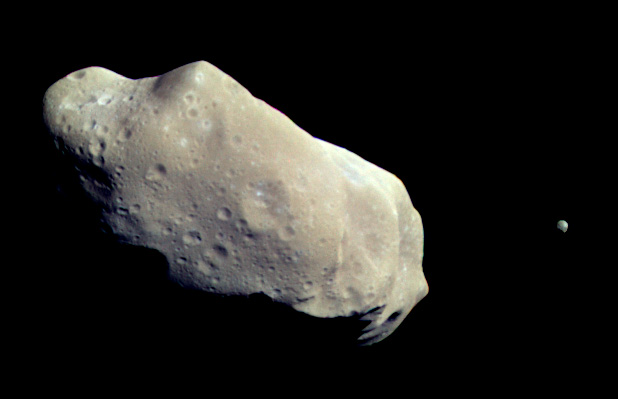Ofbeeldienge:243 ida crop.jpg
243_ida_crop.jpg (618 × 399 pixels, bestandsgrootte: 50 kB, MIME-type: image/jpeg)
Bestandsgeschiedenisse
Klik op een datum/tijd om het bestand te zien zoals het destijds was.
| Datum/tijd | Miniatuur | Afmetingen | Gebruiker | Opmerking | |
|---|---|---|---|---|---|
| huidige versie | 26 mrt 2009 05:02 |  | 618 × 399 (50 kB) | Chzz | {{Information |Description=This color picture is made from images taken by the imaging system on the Galileo spacecraft about 14 minutes before its closest approach to asteroid 243 Ida on August 28, 1993. The range from the spacecraft was about 10,500 kil |
Bloadn met dizze ofbeeldienge
Der is/zyn verwyzieng(e)n noar dit bestand ip de volgende bloadn:
Globaal bestandsgebruik
De volgende andere wiki's gebruiken dit bestand:
- Gebruikt op ar.wikipedia.org
- كويكب
- بوابة:علم الفلك/مقالة مختارة
- بوابة:المجموعة الشمسية/مقالة متميزة
- 243 إيدا
- ويكيبيديا:مقالة الصفحة الرئيسية الجيدة/482
- بوابة:علم الفلك/مقالة مختارة/25
- قائمة الكواكب الصغيرة والمذنبات التي زارتها مركبات فضائية
- بوابة:المجموعة الشمسية/مقالة متميزة/11
- قمر كويكبي
- بوابة:كواكب صغيرة ومذنبات
- بوابة:كواكب صغيرة ومذنبات/مقالة مختارة
- بوابة:كواكب صغيرة ومذنبات/مقالة مختارة/1
- Gebruikt op arz.wikipedia.org
- Gebruikt op ast.wikipedia.org
- Gebruikt op az.wikipedia.org
- Gebruikt op beta.wikiversity.org
- Gebruikt op bn.wikibooks.org
- Gebruikt op br.wikipedia.org
- Gebruikt op bs.wikibooks.org
- Gebruikt op ca.wikipedia.org
- Gebruikt op ce.wikipedia.org
- Gebruikt op ckb.wikipedia.org
- Gebruikt op da.wikipedia.org
- Gebruikt op el.wikipedia.org
- Gebruikt op en.wikipedia.org
Globaal gebruik van dit bestand bekijken.



